The maple tree is known for its striking fall color and distinctive leaves. Native to many areas in North America, maples grow in wooded areas. All maple trees are deciduous, losing their leaves in winter and growing new foliage the following spring. A number of maples become quite large when mature and make excellent shade trees when given room to spread.
Maples are distinguished by opposite leaf arrangement. The leaves in most species are palmate veined and lobed, with 3 to 9 (rarely to 13) veins each leading to a lobe, one of which is central or apical. A small number of species differ in having palmate compound, pinnate compound, pinnate veined or unlobed leaves. Maple flowers are green, yellow, orange or red. Though individually small, the effect of an entire tree in flower can be striking in several species.
Most maples are shade-tolerant when young and are often riparian, understory, or pioneer species rather than climax overstory trees. There are many maples, ranging from the small Tatarian maple (Acer tataricum) to the towering red maple (Acer rubrum), which can reach heights of 60 feet or more. In this article, learn to know the different varieties of maple trees available around the world.
Types/Varieties Of Maple Trees
1. Silver Maple (Acer saccharinum)

Silver Maple also referred to as soft maple or white maple are large deciduous trees known for having an impressively rapid growth rate, in addition to producing a prolific amount of seeds during the spring. These trees reach maturity quickly, growing approximately 24 inches or more per season.
A mature silver maple stands between 50 to 70 feet tall with a spread of 40 to 60 feet. The opposite-facing leaves turn yellow and brown during the fall, and drop off during the winter months. In the spring, the silver maple is one of the first trees to bloom, producing showy red flowers. Silver maples have a strong oval shape, although some cultivars have branches that are susceptible to breakage, requiring careful pruning.
Inconspicuous greenish flowers appear along the shoots before the leaves unfurl in spring. The paired, winged fruit are the largest of any maple. The seeds are food for squirrels and birds; young twigs and foliage are eaten by deer. Silver maples are adaptable trees. They tolerate many different soil types, from fertile to poor soils, so long as they are moist and well-draining. This tree requires full sun, but also tolerates partial shade.
2. Big Leaf Maple (Acer macrophyllum)

Bigleaf Maple also referred to as Oregon Maple is a large deciduous tree that can soar to heights of 100 feet in the wild. In home gardens, they’re usually a much cozier size. It is native to western North America, mostly near the Pacific coast, from southernmost Alaska south to southern California.
The leaves of Bigleaf Maple, as the name implies, are the largest of maple leaves. Generally, deeply lobed (occasionally 3-lobed) leaves ( measuring 8-12” long and wide) emerge with burgundy tones in spring, mature to glossy medium to deep green, and finally turn yellow to yellow-orange in fall. The Petioles contain a milky sap. In spring, bigleaf maple produces flowers in pendulous racemes 10-15 cm (4-6 in) long, greenish-yellow with inconspicuous petals.
Bigleaf maple generally grows on coarse, gravelly, moist soils, such as those found near river, lake, or stream edges, but it can occur on other moist soils such as seepage areas. It commonly occurs in mixed groups of trees with red alder, black cottonwood, Douglas-fir, western redcedar, and western hemlock.
3. Shirasawa’s Maple (Acer shirasawanum)

Shirasawa maple also referred to as fullmoon maple is a species of maple native to Japan. It is grown as an ornamental tree in gardens for its foliage and autumn color.This species grows as a deciduous large shrub or small tree growing to 8–15 m tall with a trunk up to 50 cm diameter. The bark is smooth on both young and old trees. The shoots are slender, and hairless. The leaves are rounded, 4.5–8 cm long and 6–12 cm broad.
In autumn, the leaves turn bright gold or orange to dark red. The flowers are 1 cm diameter, with five dark purplish-red sepals, five small whitish petals (soon lost), and red stamens; they are andromonoecious, with inflorescences containing flowers with either both sexes, or just male, and are produced 10–20 together in erect terminal corymbs in early spring soon after the leaves appear.
4. Coral Bark Maple (Acer palmatum)

The Sango-Kaku Japanese maple (Acer palmatum), commonly known as the coral bark maple, named for its winter display of soft coral to bright salmon-colored branches, provides a focal point in the garden to cheer even the gloomiest day. It grows as a small tree reaching about 10-30 feet tall. This tree features bright green palmate leaves spring through summer and yellow to light red foliage in fall.
The coral bark maple yields inconspicuous red flowers in spring. It is grown for its showy orange, red and yellow leaves in the fall, and for its red twigs and bark that give a pleasing contrast to otherwise drab winter colors in a garden. Cool winter weather, combined with sun, will sharpen the color of its coral bark. It can be grown in a container, growing 6 to 10 feet tall.
5. Japanese Maple (Acer palmatum)
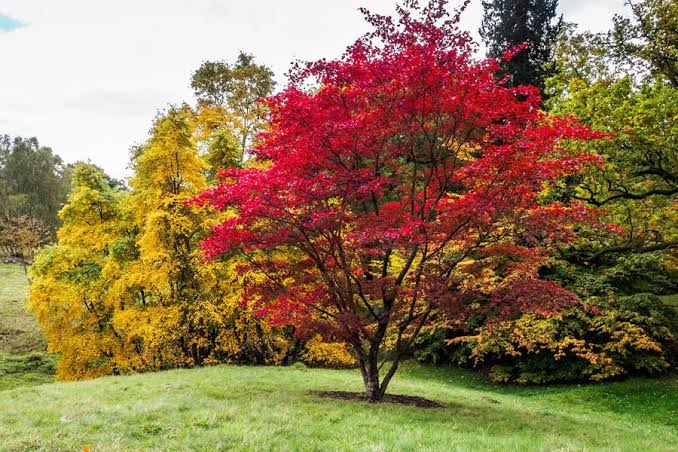
Japanese maple (Acer palmatum) is a popular landscape tree native to China and Japan. The tree is known for their cascading branches, spread canopies of red, green, reddish purple and variegated color patterns in hundreds of cultivars. The tree is characterized by a low growth habit, usually staying under 20 feet tall, and deeply dissected leaves, with branches that cascade toward the ground.
The Leaves of Japanese maple form are oppositely arranged, hand-shaped, 2 to 5 inches long and have 5 or 7 lobes. Leaves emerge in early spring. Summer color is green and autumn color varies from orange to yellow to red to purple.
Also Read: Different Types of Snake Plants
6. Laceleaf Japanese Maple (Acer palmatum dissectum)

Lace-leaf Japanese red maple trees (Acer palmatum dissectum) are named for the deeply dissected, delicate leaves that give these trees a lacy, elegantly drooping appearance. This ornamental deciduous tree reaches 6 to 12 feet tall, spreading 9 to 15 feet wide. These trees are grown primarily for their decorative leaves, but they also exhibit red blossoms in the spring. Growing this low-maintenance tree gives the yard a beautiful showcase plant.
The tree can be grown in a container as well as in the ground, and it produces delicate, wispy leaves. Japanese laceleaf maple trees prefer rich, well-drained acidic soil, plenty of moisture, and minimal fertilizer and pruning.
7. Three Flowered Maple (Acer triflorum)

Acer triflorum also referred to as the three-flowered maple is a small deciduous tree that typically grows 20 to 30 feet in height with a comparable spread. Trees are upright and spreading with a dense, delicately branched crown. The leaves are trifoliate, meaning comprised of three leaflets, and opposite. The leaflets are oval to lance-shaped and dark green and slightly fuzzy above. Dark green leaves change to rich yellow and red in the fall. Three-flower maple has vertically peeling ash-brown to almost golden amber bark.
8. Autumn Blaze (Freeman Maple)

Also known as a Freeman maple, the Autumn Blaze is a hybrid between the red maple (A. rubrum) and silver maple (A. saccharinum). It can expand up to 50 feet in height and sports a branching system that narrows as it reaches the crown.
The Autumn Blaze maple has simple, star-shaped leaves with palmate venation, or veins growing in a fan shape, that reach up to 5 inches in length. Leaf margins have toothed edges, and they’re arranged at opposite positions – meaning leaves grow directly across from one another on a branch. The leaf blade is between 2 and 4 inches long and has a red or green petiole where the leaf stalk is attached to the stem.
Although reddish leaves emerge in spring, the foliage turns green as the leaves mature. It’s in fall, however, that the tree really puts on a display by creating a vibrant, showy display of yellow, orange or brilliant red that lasts several weeks.
It prefers well-drained moist, acidic soil in the full sun to partial shade. It makes an excellent shade, lawn, or street tree that can tolerate heavy clay soils and even occasionally wet soils. Once trees are established they can tolerate some drought.
Also Read: Different Types of Monstera-varieties
9. Sugar Maple (Acer saccharum)

Sugar maple (Acer saccharum) is a common ornamental deciduous shade tree. The tree grows 60 to 75 feet tall with up to a 50-foot spread. Sugar maples are often planted for their show of color in the fall, when their green leaves turn yellow, orange or dark red. Sugar maples tolerate almost all soil types as long as the soil is not salty.
This variety of maple provides the sap for making maple syrup. Whether growing the tree for shade, for ornamental value, for making syrup or as a container plant such as a bonsai, starting the tree from seed is an economical way to grow your own sugar maple.
10. Red Maple (Acer rubrum)

With varieties in either full rounded or upright forms, red maple trees have a high canopy that allows you to see its branch structure. Not only does the tree have a stunning fall display with red twigs and multicolored leaves in red and orange, it also has bright red buds in the spring. The buds open to show red flowers and, later, dangling red-winged fruit, called samaras, that are as attractive as the flowers. Red maple is also referred to as swamp maple, Carolina red maple and scarlet maple.
Red maple trees grow about 36 inches each year and can grow up to 120 feet tall, though they average about 40 to 50 feet. The trees live anywhere from 50 to 150 years and work well as specimen trees in a landscape that can accommodate their size. Since they like both wet and dry soils, they work next to ponds or creeks and also in drier areas. The tree doesn’t work well near sidewalks or driveways because its roots grow close to the surface and can cause those surfaces to buckle.
11. Norway Maple (Acer platanoides)

Acer platanoides, commonly known as the Norway maple or Crimson King Maple, is a large deciduous tree that can grow up to approximately 40-60 feet in height with a broad, rounded crown. The bark is grey-brown and shallowly grooved. Unlike many other maples, mature trees do not tend to develop a shaggy bark. The shoots are green at first, soon becoming pale brown. The leaves are opposite, palmately lobed with yellow, occasionally orange-red color during the autumn. The winter buds are shiny red-brown.
12. Full Moon Maple (Acer shirasawanum ‘Aureum’)
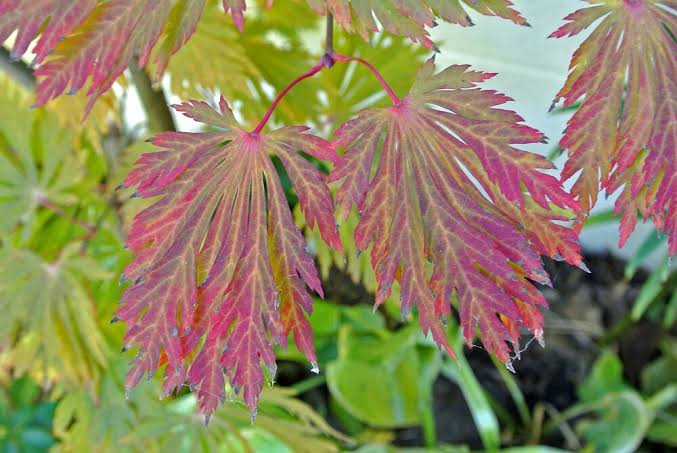
Acer shirasawanum ‘Aureum’ known as ‘The Full Moon Maple’ or “Golden Full Moon maple” has large chartreuse orbicular leaves with bright red petioles which make this one of the most desired maples. This slow-growing deciduous tree takes about 10 years to read 6 feet high. Yellow flowers appear in the spring after the chartreuse-gold leaves unfurl. Seed capsules resembling wing nuts follow the blossoms. The bright-colored leaves turn orange-red in autumn. This ornamental maple acts as a focal point in home gardens.
13. Paperbark Maple (Acer griseum)

The paperbark maple (Acer griseum) features a deeply textured, layered bark and thick, dramatic foliage that makes the plant ideal as an ornamental or a shade tree. When mature, the paperbark maple grows to about 15 to 30 feet tall and wide, usually with an oval to a rounded oval shape. In rare instances, old trees may grow as high as 40 feet. This tree grows more slowly than many maples and may take 20 years to reach full height.
As a relatively small deciduous tree, paperbark maple provides unique beauty to the landscape, thanks to its fall color (typical of maples) and its peeling copper-orange to reddish-brown bark (quite unusual for maples). Thus, this tree adds ornamental interest year-round.
Paperbark maples produce greenish flowers in spring (usually April), but the blooms are not significant. The flowers then give way to the familiar maple seed samaras (winged seed pods), about 1 1/4 inches long. The seeds are unusually large for maples.
Also Read: Different Types of Cypress
14. Amur Maple (Acer ginnala)

Amur Maple (Acer ginnala) has 3-lobed leaves, with the middle lobe longer than the others and tapering to a sharp point. Each leaf is 1-1/2 to 3 inches long. The large multi-stemmed shrub or small tree can grow 15 to 18 feet in height, with an equal spread.
Amur maple bark is gray-brown and smooth with some dark stripes or striations. The dark green, glossy foliage turns yellow and red in the fall. The yellow-white flowers are fragrant and open in mid to late spring. Seeds are borne in winged, propeller-shaped samaras. In April and May, panicles of small fragrant white flowers are produced.
The brilliant red fall foliage and compact shape of the amur red maple (Acer ginnala) make the deciduous tree a smart choice to anchor a front-yard planting or provide a focal point in a mixed border.
15. Hedge Maple (Acer campestre)

The hedge maple (Acer campestre) is a Medium-sized deciduous tree with highly variable shape. It can be used for its timber and as an ornamental plant. They have a rounded shape and low branches that nearly touch the ground at the base. The base can even become mulit-stemmed and grown as a shrub.
Hedge Maple has dark green foliage throughout the season. The lobed leaves turn yellow in fall. Neither the flowers nor the fruit are ornamentally significant. Its average texture blends into the landscape, but can be balanced by one or two finer or coarser trees or shrubs for an effective composition.
16. Hornbeam Maple (Acer carpinifolium)
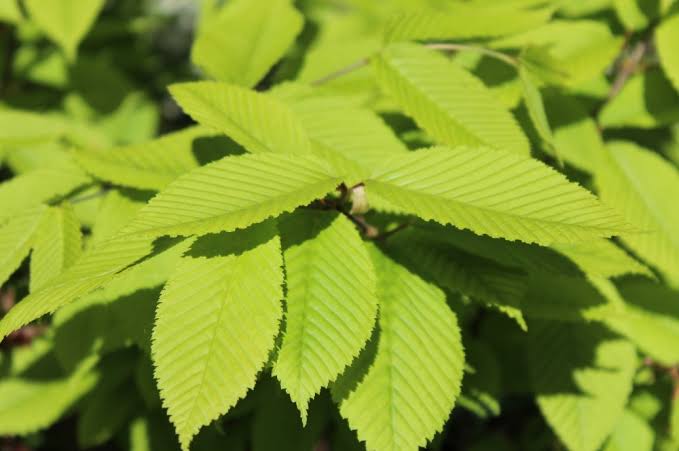
The rare Hornbeam Maple (Acer carpinifolium) can be a tricky tree to identify. It grows in woodlands and alongside streams in mountainous areas.
It is a small deciduous tree growing to 10–15 m tall, with smooth, dark greenish-grey to grey-brown bark. The leaves are 7–15 cm long and 3–6 cm broad, simple, unlobed, and pinnately veined with 18–24 pairs of veins and a serrated margin. They resemble leaves of hornbeams more than they do other maples, except for being arranged in opposite pairs, and in the very small basal pair of veins being palmately arranged as in other maples.
It is occasionally cultivated as an ornamental plant in temperate regions, mainly as a botanical curiosity to demonstrate the wide range of leaf morphology in the genus Acer, but also for its bright yellow autumn color.
Also Read: Different Types of Juniper Trees
17. Sycamore Maple (Acer pseudoplatanus)
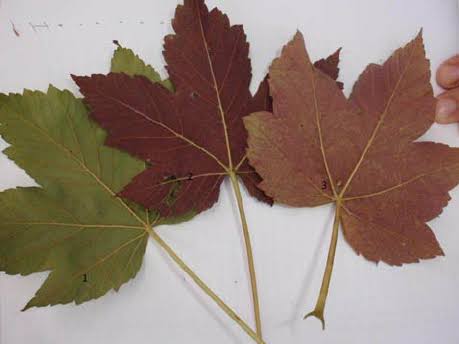
Acer pseudoplatanus, known as the sycamore in the United Kingdom and the sycamore maple in the United States, is a large, flowering plant species, deciduous and broad-leaved tree, tolerant of wind and coastal exposure.
A Sycamore maple can grow up to 40 meters (132 ft) tall and can reach a trunk circumference of up to two meters (7 ft). The tree species stands out particularly by their stately growth and their distinctively pronounced treetop. Especially as a solitary tree, the sycamore can develop into a magnificent tree.
Sycamore has a characteristic leafy shape similar to that of Norway maple, but the sycamore leaves are rounded. The leaves have long, reddish colored stems, which are usually five-lobed, with the front three lobes are about the same size. Often the two lower lobes are not fully formed. The underside of the sycamore leaf is gray-green in color, while the top is dark green. The leaf position of this tree is opposite. The leaves turn intense in autumn, from gold-yellow to red. Especially after the first frosty nights, the discoloration progresses rapidly.
18. Tatarian Maple (Acer tataricum)
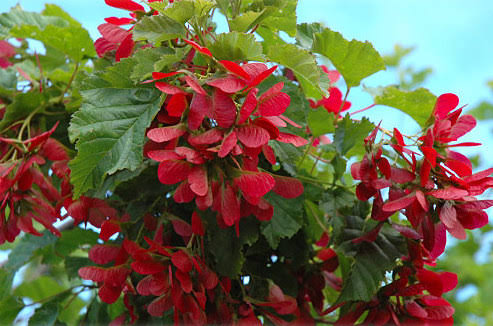
Tatarian maple trees (Acer tataricum) are small trees or large shrubs native to native to western Asia. They may grow 20 feet (6 meters) tall, but often spread to 25 feet (7.6 meters) or wider. Despite this short height, they shoot up fast, sometimes 2 feet (.6 meters) per year. These trees are considered ornamentals. They produce panicles of greenish-white flowers in springtime. The fruit is also eye-catching: long, red samaras that hang on the tree for a month or so before falling.
Tatarian maple trees are deciduous trees, losing their leaves in winter. During the growing season, their leaves are green, but according to Tatarian maple facts, they turn yellow and red in fall. This makes growing a Tatarian maple a great tree to get fall color in a small landscape.
19. Vine Leaf Maple (Acer cissifolium)

Acer circinatum also referred to as the vine maple commonly grows as a large shrub growing to around 5 to 8 metres (16 to 26 ft) tall, but it will occasionally form a small to medium-sized tree, exceptionally to 18 metres (59 ft) tall. The shoots are slender and hairless. It typically grows in the under story below much taller forest trees, but can sometimes be found in open ground, and occurs at altitudes from sea level up to 1,500 meters.
The leaves are pinnate and are composed of three single leaves. The individual leaves are irregularly sinuate, ovate and pointed. The petiole is long and reddish, leaf margin coarsely toothed and the leaf arrangement is alternate. The leaves turn bright yellow to orange-red in fall.
Vine maple trees can bend over easily. Sometimes, this can cause the top of the tree to grow into the ground and send out a new root system, creating a natural arch. This characteristic makes it the only maple capable of layering.
20. Snakebark Maple (Acer tegmentosum)

Snakebark Maple is a small to medium understory tree native to China and Myanmar growing 30 to 50 feet tall and 20 to 40 feet wide. It is often shorter and multi-trunked with arching branches and a spreading crown. Snakebark Maple is part of a group of trees known for the striped look of the bark.
Snakebark Maple is covered in stunning racemes of yellow flowers along the branches in early spring. It has bluish-green foliage with dark green veins which emerges light green in spring. The serrated lobed leaves turn an outstanding gold in the fall. The fruit is not ornamentally significant. The smooth bluish-green bark and light green branches are extremely showy and add significant winter interest.
Also Read: Different Types of Pothos Plant
21. Korean Maple (Acer pseudosieboldianum)

The deciduous Korean Maple (Acer pseudosieboldianum) is also sometimes referred to as the Purplebloom Maple. This is because it produces unique little purple flowers when the new foliage begins to appear in spring. It grows about 12 to 18 inches per year. The mature tree is 15 to 25 feet tall.
The leaves are 4 to 6 inches wide and have usually 9 to 11 lobes. The green leaves turn shades of red, yellow and orange in fall. This species exhibits Marcescence (tends to hold on to a portion of its dried leaves through the winter). The flowers are white with purple bracts. New growth is coated in white, sticky hairs. This characteristic distinguishes the plant from the similar Acer sieboldianum, which lacks hairs.
22. Painted Maple (Acer pictum)

Painted maples (Acer pictum) hail from Japan, China, Korea, Mongolia and eastern Russia. They typically grow 40 to 60 feet tall, forming a rounded crown with spreading branches. The painted maple is one of the few varieties hardy up to zone 9. New spring leaves are bronze tinted, bright green in summer and transform into shades of yellow and orange for its fall costume. Upright clusters of greenish-yellowish flowers bloom in late spring. They generally do not have critical issues with insects or disease but can be infected with verticillium wilt, leaf spots, tar spot, root rot, anthracnose, collar rot or stem canker.
23. Trident Maple (Acer buergerianum)

The trident maple (Acer buergerianum) is attractive to both beginning and experienced bonsai growers. It is a fast-growing tree that tolerates a wide variety of growing conditions. Trident maple features leaves that are 1-1/2 to 3-1/2 inches long, with 3 lobes apiece. The foliage is bronze-purple when new, becoming green at the advent of summer, and turning shades of red, yellow and orange in the fall. The tree grows 20 to 30 feet tall, with a similar spread. The flowers are relatively insignificant green-yellow fluffy umbels or flat-topped flowerheads. Seeds are borne in winged samaras that are 3/4 to 1 inch long. The bark is a ruddy gray-brown and develops an exfoliating or pealing character as the tree matures.
24. Miyabe Maple (Acer miyabei )

Acer miyabei also referred to as Miyabe’s or Miyabe maple is a small to medium-sized deciduous tree growing to 10–20 m tall, with a trunk 30–40 cm diameter with rough, grey-brown bark. The leaves are five-lobed (the basal pair of lobes usually small), 7–20 cm long and 12–20 cm broad, with a 5–15 cm long petiole; the petiole bleeds white latex if cut. The flowers are produced in spring at the same time as the leaves open, yellow-green, in erect corymbs. The fruit is a samara with two winged seeds aligned at 180°, each seed 8 mm wide, flat, with a 2 cm wing.
25. Shantung Maple (Acer truncatum)

The small, rounded Chinese Shantung maple (Acer truncatum) reaches heights of 25 feet with dense branching at the crown and a spread equal to its height. The cold-hardy specimen produces reddish purple leaves in the spring and progresses to dark green, turning many shades of yellow, orange, purple and red during the autumn season. Yellow flowers appear in April. Shantung maples generally do not suffer from insect and disease problems.
Further References
- Maple Tree Facts: https://en.m.wikipedia.org/wiki/Maple
- Beautiful Species of Maple Trees: https://www.thespruce.com/thirteen-species-of-maple-trees-3269671
- What You Need To Know About Maple Trees: https://www.britannica.com/plant/maple-tree
- Fast Growing Maple Trees: https://homeguides.sfgate.com/grow-herb-garden-indoor-outdoor-13771633.html
- Maple Tree Varieties: https://www.gardeningknowhow.com/ornamental/trees/maple/maple-tree-types.htm